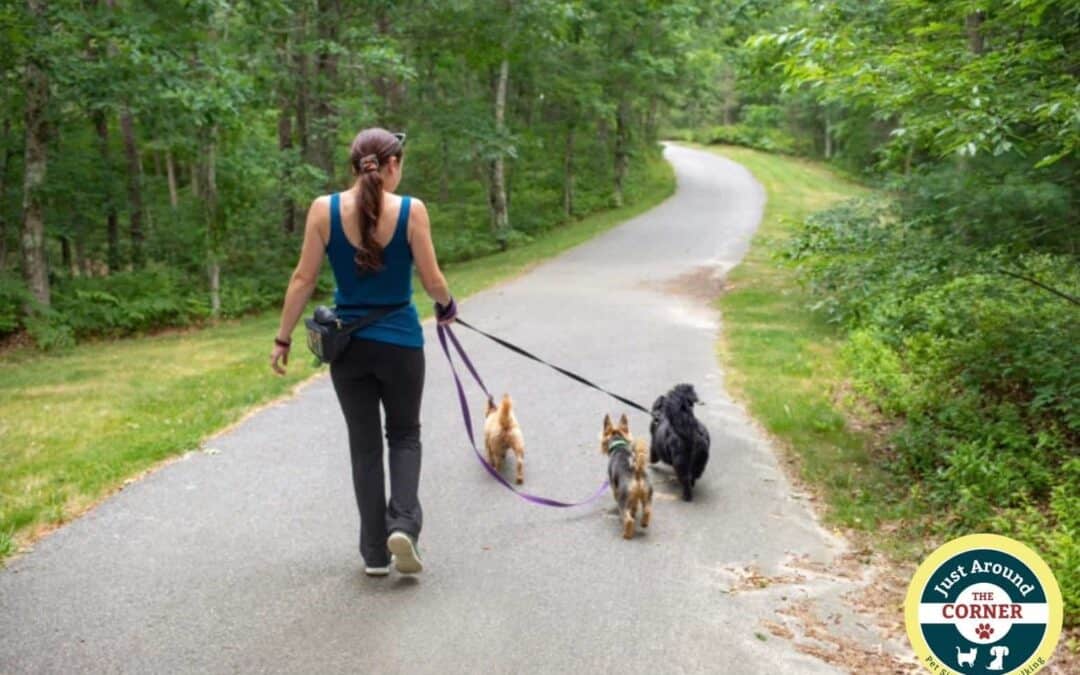
by Pam Ranheim | Sep 15, 2020 | dog walking, dogs, pets, Plymouth MA
The sun is out, a light chill fills the air, and the tourists have all gone home. It is a perfect day to explore a dog friendly trail with your precious pooch right here in Plymouth. Summer has faded fast and fall is quickly approaching which means our furry friends are once again welcome to roam on most beaches and trails, yay! If you are looking to spice up your routine with Buster or get Lucy out for a nice run why not hit a wide, well maintained, trail that offers scenic views just minutes from home. On the surface our town is stunning, this we know, but hidden throughout its 100 square miles are trails you never knew Plymouth had to offer. Did you catch Part 1 of our Dog Friendly Trails in Plymouth series? Learn about 5 more totally PAWesome trails that you and your pup will love here.
What to pack?
Anytime we take our dog somewhere there are basics we want to have on hand, right? For example, we can all agree that it is never a good idea to leave home without poop bags. But what about when you are planning for a long-distance hike in a pretty remote location? When you are preparing for a venture to one of these trail locations the list of essentials is a bit more extensive. Being prepared is paramount to ensure the safety of you and your pup as you embark on your new adventures. Download our FREE list of Excursion Essentials for Your Pup and share with friends!

5 Plymouth Hiking/Walking Trails
ATTENTION: Check the Massachusetts Toxic Algae Pond Advisory list before you or your dog enter or drink the water of any pond listed in the following descriptions.
Little Pond Loop @ Morton Park
We could not resist starting the list off with Little Pond Loop at Morton Park. The towering forestry and beautiful blue water of Lout Pond and Billington Sea are unlike any other trail views in Plymouth! The wide, well worn paths make for easy use and keeps social distancing effortless. There are picnic tables and a recreational area near the parking lot at the main entrance. Your pup is sure to enjoy running the open trails and taking a dip before the car ride home. The trail itself is not clearly marked so if you are not interested in exploring a few paths that lead to nowhere we suggest downloading the All Trails app to ensure your 2.7 miles does not turn into 5+. Overall, the beauty, easy to use trails, and variety of activity options in Morton Park make this trail a must use!
Trail Length: 2.7 miles
Address: Morton Park Rd.
Route Type: Loop
Parking: Large lot just down from the main entrance
Map: Morton Park Trail

Cranberry Bogs via Eel River Preserve Trail
If you love observing nature this is the trail for you! The abundance of wildlife in their natural habitat all along this trail is well worth the low land sludge you may encounter. The trail is low lying land so depending on recent weather patterns it may be quite muddy. If you are looking for a lesser known trail to explore all to yourself, this is the way to go! Excellent option for dogs who do not prefer the company of other dogs or humans. Come prepared with your waterproof shoes and bug spray to make this trail a positive experience.
Trail Length: 2.2 miles
Address: 204 Long Pond Rd. Plymouth, MA
Route Type: Loop
Parking: In lot at 204 Long Pond Rd.
Map: Eel River Preserve Trail
East Head Pond Trail @ Myles Standish
Rated the number 1 trail in all of Plymouth according to All Trails, East Head Pond Trail will not disappoint. This picturesque trail leads you around the full loop of East Head Pond. Stunning views of the water and blooming flowers are sure to keep your attention throughout the entire 2.6-mile loop. The flat terrain makes it an excellent choice for all skill levels and all size dogs. Its easy use and clearly marked signs will keep you on the right path without a second thought about it. Note that the trail is a bit narrow, but the light foot traffic makes social distancing easy. Wonderful choice for the whole family!
Trail Length: 2.6 miles
Address: 194 Cranberry Rd. (area of)
Route Type: Loop
Parking: Parking areas along the entrance of the State Park
Map: East Head Pond Trail/Myles Standish
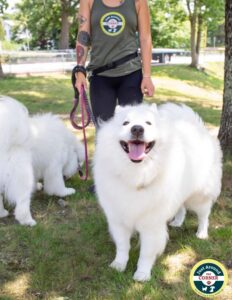
Bentley Loop @ Myles Standish
Measuring in at just under 4 miles, Bentley’s Loop will get the blood pumping and lungs working for you and your pooch. Popular activities on this trail include mountain biking, horseback riding and of course hiking. Most importantly, dogs are more than welcome but must be kept on leash for this loop. Soak up the lovely seasonal flowers and foliage while catching a glimpse of the many varieties of birds who occupy this area. On a trail nearly 4 miles clearly marked navigation signs are a must and Bentley’s Loop does an excellent job of it. While there is no direct access for pond swimming there are a few access paths that lead to various small ponds for you and your pup to take a dip. Be sure to check the list of local Toxic Algae Ponds before letting your dog (or you) dive in.
Trail Length: 3.8 miles
Address: 194 Cranberry Rd (area of)
Route Type: Loop
Parking: Parking area near east entrance off Upper College Pond Rd..
Map: Bentley Loop/Myles Standish
Gramp’s Loop Trail @ Halfway Pond Conservation
Enjoy the gentle hills and impressive forestry while exploring 2 miles of well-kept trail. The hills increase in some areas of this trail making it ideal for larger dogs or fur babies not so low to the ground. Sneak peaks of Halfway Pond and benches at the most opportune times make Gramp’s Loop a wonderful spot for picnicking or an afternoon relaxing in the great outdoors. This is a lightly trafficked trail with clearly marked navigation signs to ensure you are never lost. Dogs are welcome here year-round, so don’t miss out on this hidden gem!
Trail Length: 2 miles
Address: Mast Rd. Plymouth, MA (area of)
Route Type: Loop
Parking: Parking area at entrance of the Conservation off Mast Rd.
Google Maps directions HERE
Map: Gramp’s Loop/Halfway Pond Conservation Area
Tick Check? You bet!
Don’t forget to do a tick check on your pup as well as yourself after every trail adventure. No time of year is 100% free from ticks as they can survive in temperatures as low as freezing. Even if your pet is on a tick preventative you should still give them a once over after having been in wooded and thickly settled areas. Don’t let a splendid adventure turn into a pest nightmare for you or your furry friend. Need more information about ticks? Check out our Blogs 6 Tips to Keep Your Dog and Cat Flea- and Tick-Free and Ticks Trailside
We’d love to hear from you!
Have you been convinced to get out there with your pup and start exploring? Are you feeling reinvigorated to try a new trail in Plymouth? Comment below with your favorite trails, comments, or questions about the trails we talked about today, let us know if you visit one of them. Check back for more local trail info soon!
Just Around the Corner offers daily Dog Walking , Dog Hiking, and Pet Sitting in Plymouth, MA. To learn more about how Just Around the Corner can help, check out our Services Page. You can also Contact Us for more information. Be sure to Like us on Facebook and Follow us on Instagram!
Resources:
www.Alltrails.com
https://www.plymouth-ma.gov/marine-and-environmental-affairs/pages/town-plymouth-trail-maps
https://www.mass.gov/alerts/harmful-cyanobacterial-bloom-advisories-in-massachusetts#undefined

by Pam Ranheim | Aug 27, 2020 | dog training, dogs, pet care, pet health, pets, Plymouth MA, puppy
It is time to Potty Train your puppy! You have your adorable new puppy home and settled in. She snuggles and licks your face – so sweet. But then, she also pees on your favorite rug, or poops in the corner of the kitchen. Ugh – Where to begin?! Time for Potty Training 101! What you do for potty training in the first few weeks of having a puppy will follow you through the life of your dog. Think of house-training your dog as the foundation of a happy life together. Keep it simple with a schedule, stay consistent and have a positive attitude, and your puppy will be a potty-trained pro in no time. You can do this!
Potty Training: First Things First
The goal of potty training is for your puppy to only poop and pee outdoors, in the spot you want them to. If they need to go out, you want them to let you know. You can begin potty-training your puppy as soon as they arrive (8 weeks). Usually pups start to gain control over their bladder around 12 weeks, but get them used to a regular potty routine as soon as they join your family as an important part of the potty-training process. For the first week or two…play inside, business outside other than short walks on leash. The reason for this is that, when you get your puppy, they will have been with their littermates and have been able to pee and poop as they play in their play area. Puppies are used to this. If you have them playing outside and they do their business while playing, then when you come inside and play they will do the same. They will not know the difference between playing outside or inside and being able to just stop and pee. So, make outside for business-only in the beginning. It will not take long before they understand, and you will be able to have lots of fun outside!
To prepare to house-train your pup there are a few things to do in advance.
- Choose where their “SPOT” will be outside. Decide on an area that is easily accessible for them, a decent size (min. 10’x10’), and that you can stay consistent with.
- Don’t keep your outside potty area spotless. Leave a little so your pup can have the necessary smells to know that is where you want them to go.
- Research the many Potty-Training methods out there to gain as much knowledge of the process as possible.
- Observe your puppy’s habits to assess how well/long your puppy can control their bladder before starting to train. This usually takes a week or two leading up to starting your training.
Potty-Training Schedule
As a general rule the number of hours a puppy can go without using the bathroom is the equivalent to how many months old they are. For example, a 2-month (8 week) old pup can usually go 2 hours between potty breaks, a 3-month old can go 3 hours, and so on. As your puppy grows the hours between relief will also grow and your schedule will vary depending on their house-training progress. For anyone beginning to potty train their dog this schedule is an excellent place to start. Download our free Potty Training 101 Schedule to use as your daily guide: 8-12 Week Schedule 12-16 Week Schedule
6:00 AM Wake up & right out to POTTY
6:15 AM Breakfast
6:30 AM Post breakfast POTTY
9:30 AM Mid-Morning POTTY & Walk
12:00 PM Post Nap/Pre-lunch POTTY
12:15 PM Lunch
12:30 PM Post Lunch POTTY
3:30 PM Afternoon POTTY & Walk
6:00 PM Post Nap/Pre-dinner POTTY
6:15 PM Dinner
6:30 PM After dinner POTTY
9:30 PM Last POTTY before bed (this time will adjust depending on your personal bedtime)
NOTE: Your puppy will not be able to make it through the night without an accident. Be prepared to get up during the night every 2-3hours to take your puppy out.
Remember to always take your pup out for relief following naps and playtime. In addition, a potty break is needed before and after all meals. This schedule is only a starting point. Do not forget to adjust with your growing puppy as needed. Get a FREE age appropriate schedule for your pup here: Potty Training 101 Schedule: 8-12 Weeks 12-16 Weeks

Consistency is KEY
Whatever your schedule looks like, keep it consistent for your dog. Constantly changing up their routine confuses them and can wind up setting back the progress you may have already made. The hours between potty breaks will increase as your pup grows but keep feeding times and walks on the same schedule whenever possible to maintain their regimen. If you are a working puppy mom or dad a regular schedule may seem impossible. Hiring a dog walker/pet sitter for times you are unavailable keeps up the consistency for your pet and expedites the house-training process. Typically, by 4-6 months you will be able to judge for your puppy what their best long-term routine is as every dog is different.
Stay Positive through the House-Training Process
Keep it PAWsitive for your pup! We know how frustrating it can be when our pet uses the bathroom inside, especially on our favorite rug. No matter how trying the times of training may be your pet will respond best to a positive attitude and constructive actions. Punishing your puppy for an accident in the house is not going to teach them what you want them to do. Instead of punishment try clapping loudly to get their attention if you catch them in the act. Verbalize NO or another word they are familiar with and take them outside immediately to teach them the correct way to use the bathroom. Let us not forget the successes; when your pup does their business outside praise them! Your dog wants to please you. Giving extra love and even a cookie will create positive association for your dog making them more eager to please you every time, thus becoming house-trained.

Signs your pup needs to potty
During the first few weeks of your potty-training quest it is important to keep a close eye on your pup. Look for the signs that they need to relieve themselves. Each pup will have his or her own sign, which you can learn by watching carefully. To get started, once they exhibit any of the signs listed below take them to their “potty spot” outside as quickly and gently as possible. Soon you will recognize their “I gotta go” behavior and be able to respond appropriately.
- Sniffing
- Whining
- Circling/Restlessness
- Licking the groin area
- Standing still and lifting the tail (That’s our mascot Quinn’s move)
- Going to a previously “used” in-house area
- Squatting (Catch them quick with this one!)
You can do it!
Potty training your precious pooch is a big responsibility that you can totally handle! When you keep a consistent schedule and stay positive with your pup in everything from the praise to the corrective actions you will have a house-trained fur baby in no time. Remember that puppies are not puppies forever and one day (soon!) the trials of potty training will be a distant memory. Soak it up while you can. Create a schedule that works for you and find ways to keep it up no matter what. Whether you hire a dog walker for additional help or recruit your mom or neighbor to avoid skipping potty breaks your pet will appreciate your hard work. When the day of no more accidents comes so will you!

Need help keeping your pup’s schedule?
Just Around the Corner offers a wide variety of dog walking and pet care options for you and your furry family member. We all know how difficult it can be to keep up a consistent schedule for our dog, especially while potty training. JAC is here to help! Avoid the setbacks of messing up your dog’s routine. Set up a Meet and Greet with a JAC pet care professional. Choose from a variety of visits, walks, and hiking options that best suit your dog and never worry if your pup’s schedule is “off” again! Call or text: 508-245-1389 to set up a meet and greet TODAY.
Just Around the Corner offers daily Dog Walking and Pet Sitting in Plymouth, MA. To learn more about how Just Around the Corner can help, check out our Services Page. You can also Contact Us for more information. Be sure to Like us on Facebook and Follow us on Instagram!
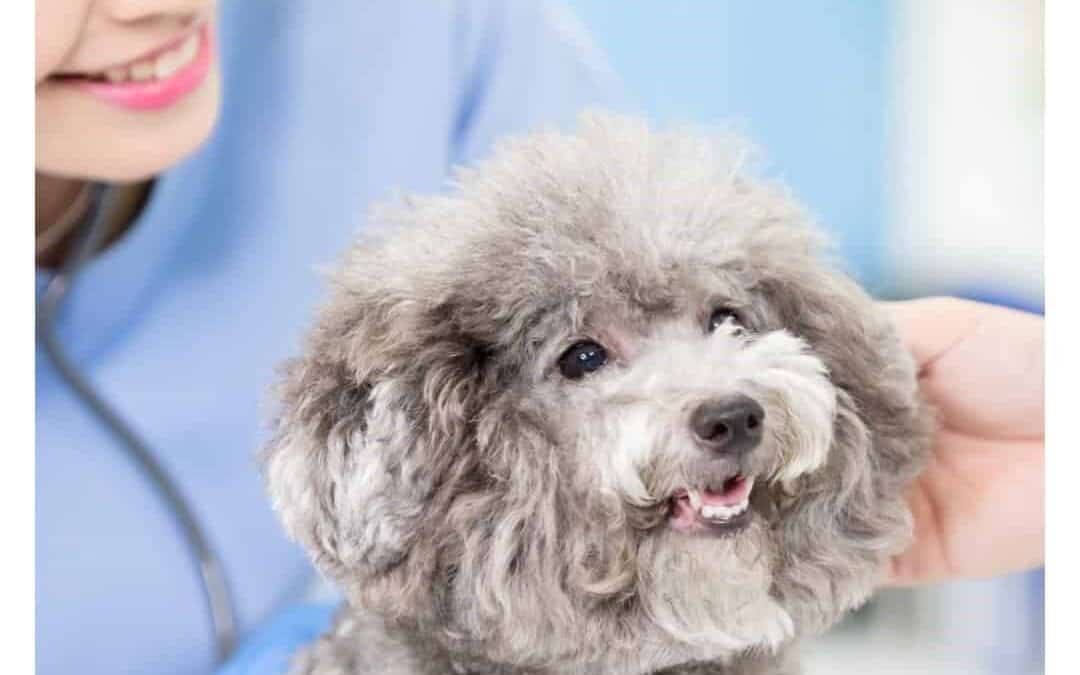
by Pam Ranheim | Aug 19, 2020 | birds, cats, dogs, pet care, pet health, pet sitting, pets, Plymouth MA
Choosing a veterinarian for your pet’s health and wellness is one of the most important decisions you will make as a pet parent. After all, the goal is to keep our fur babies healthy, happy and on Earth for as long as possible, right? Finding the right health care provider for your precious pup or fluffy feline is a personal decision that will lay the foundation for your pets’ health. If you are like me, you want quality care that comes with ease and Peace of Mind for your precious pet. Contrary to popular belief, our pets are not born hating the vet! Find a place that makes them feel comfortable and (dare I say) one they look FORWARD to going to! While the responsibility of choosing your pets’ health care provider is HUGE, the process of finding the best fit for you and your pet can and should be FUN! So, take a deep breath and follow these 7 great ways to go about choosing the best vet for your pet.
Talk to your pet owner friends
Get recommendations about the best veterinarians from people you trust who also have pet owning experience. Start by building a list of possible vets based on these recommendations. This list may also include some fair warnings of less than stellar practices based on others’ experience. Consider what type of pet or breed your friends own(ed). A 15-year-old Maine-coon cat will have a vastly different veterinary experience than a brand-new yellow lab puppy. Friends who own pets are a wonderful place to start your vet choosing process.
Research
The best vet for your pet may not fall right into your lap but with focused research the right fit will come along in no time. After gathering a list of names/practices from your pet owning pals do some of your own research. Thoroughly review each candidate’s website and read their testimonials. If people are saying things that you are looking for in a vet like “personal attention” “timely and considerate service” “open evenings and weekends” “good value” or “very professional” they may be worth looking into further. In addition to the compiled list of recommendations from your friends, a Google search for veterinarians in your area is another fabulous resource. Always read reviews and look for people who describe what you hope to find in a vet. Live in Plymouth, MA? Click here for a list of local veterinarians!
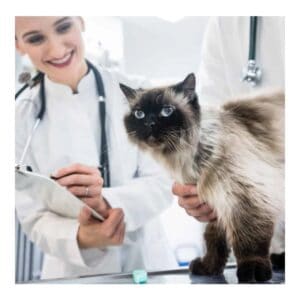
Visit (or Call) to feel it out
The best way, hands down, to learn if a vet practice will work for you and your pet is to experience it firsthand. When possible, take a trip to your top choices for a visit. You can first do this without your pet to get a feel for cleanliness, day to day operations, and whether the staff meet your friendliness standards. If the visit goes well and you are pleased with your experience, set up a trial visit for your pet. Realize that right now, in a COVID world, scheduling “research visits” may not be an option. Rather than in person, make phone calls to your top choices to inquire about their practice and ask the staff and veterinarian your questions.
Hours of Operation
The best vet for your pet means they are available when you need them! The hours and days of operation vary from practice to practice. Think ahead to what days of the week you will be available to schedule your pet’s routine visits and ensure that your vet of choice is open. If you are only available on weekends and your vet is not open Saturday or Sunday that may be a deciding factor and time to look at other options. If you choose in-home veterinary care, ask for their “on-call hours”. Many times, traveling vets hold hours of operation like a brick and mortar clinic. If the vet, you choose is not open or available 24/7 you will want an emergency veterinarian for your pet as well. Once you have chosen your primary care vet ask them for their recommendation on an emergency vet.

Location Location Location
Choosing a vet who is close and convenient is beneficial and can be life changing when it comes to an emergency. Consider your travel time to each vet clinic and decide if that is a distance you feel comfortable traveling with your pet, particularly in the event of an emergency. Knowing the proximity of a clinic is to your home is an excellent way to narrow your search.
Fees and Money Matters
When it comes choosing the best vet for your pet financials matter! To choose a vet that foremost meets your financial needs, compare the pricing of multiple clinics. Always ask ahead of time the full costs of procedures to avoid any unexpected fees. Inquire about methods of payment, payment plans or financial assistance before committing.

Connect with the Vet on your Pet Care Philosophies
Get down to business by asking the veterinarians their beliefs on practices and treatments for things like cancer, spaying and neutering, and euthanasia. If you believe in holistic and alternative treatments is this something they practice and/or condone? Is the vet patient and understanding of your questions and inquiries? The quality of health care for your pet is not something to compromise on. If a vet does not feel like the “right fit” continue your quest until you feel 100% comfortable in your decision.
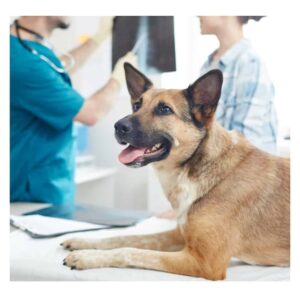
Gain Confidence in Your Choice
As a pet parent there is no greater choice to make than their health care provider. When embarking on this important quest consider others’ experiences and investigate their recommendations. Research thoroughly while getting answers to your important questions. Make the choice that works within your budget and time and choose a vet who aligns with your personal pet care philosophies. Following these guidelines will give you confidence and Peace of Mind in making your final decision of which vet to choose for your pet. Remember, choosing a vet is not like a marriage proposal. You are not looking for “the one”, you are making a choice that most closely aligns with your values and expectations of the health care provided to your pet. If your initial choice ends up not being the “right fit” you can always change!
References:
www.akc.org
www.pets.webmd.com
Just Around the Corner offers daily Dog Walking and Pet Sitting in Plymouth, MA. To learn more about how Just Around the Corner can help, check out our Services Page. You can also Contact Us for more information. Be sure to Like us on Facebook and Follow us on Instagram!
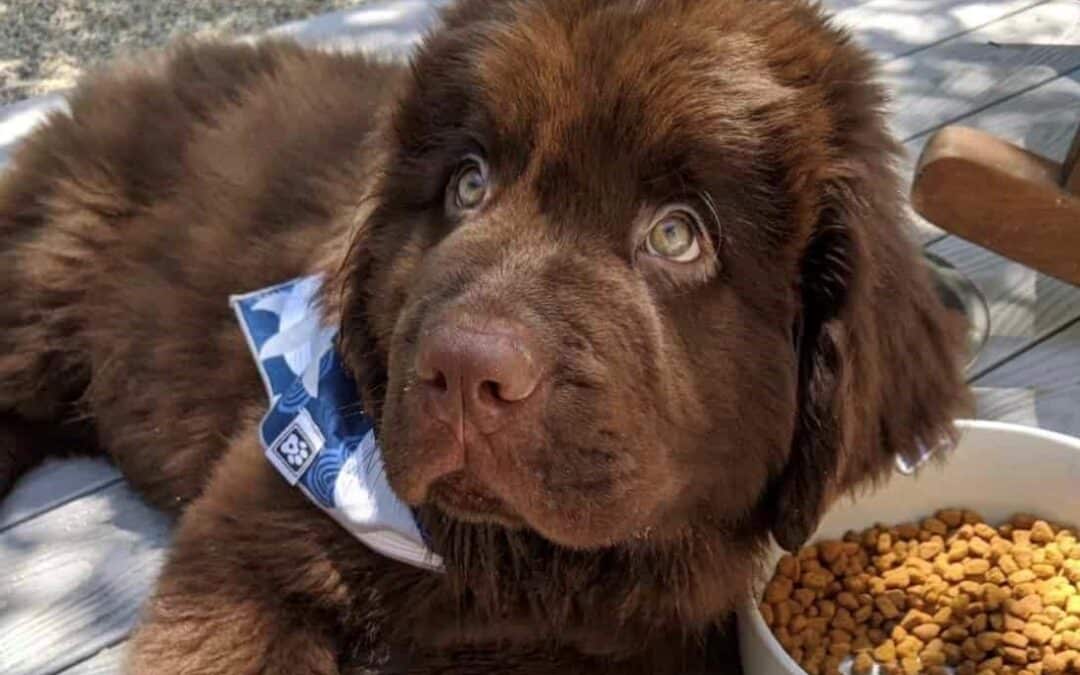
by Pam Ranheim | Aug 12, 2020 | dog walking, dogs, pets, Plymouth MA, puppy
You are getting a puppy! Wow, is there anything more exciting than preparing to bring home a brand-new fur baby? Having recently brought a puppy home ourselves, our puppy Mascot Quinn who is a chocolate Newfoundland, we can say firsthand that it is pretty darn special! You have worked diligently to research and choose the perfect dog for your life and the time has come to prepare for their arrival. If you are still in your search for the perfect pup check out our blog Choosing the Right Puppy (Dog) for Youhttps://jacpetsit.com/choose-the-right-puppy/. Much like raising a child, when it comes to puppies and dogs everyone has their own pet parenting style. In some cases, throwing an elaborate “puppy shower” before the furry bundle of joy arrives may be necessary. Others may toss the list of essentials in their Chewy.com cart and call it a day. Whatever your style may be, there are 10 universal must haves for everyone. These top 10 essentials will help to create as seamless a transition as possible for you and your new pup.
Download our printable Prepping for a Puppy Checklist to make sure you don’t leave anything out!
Top 10 Essentials
- Collar (with ID tags) and Leash
It’s time to pick up your new puppy. Don’t forget the leash and collar! Often shelter dogs will not be given to you with a collar. Make sure you come prepared with both a collar and a leash, better safe than sorry. You will also want the collar and leash when you get home to keep your puppy close and safe. Always keep an ID tag on your pet’s collar starting the moment they are in your care. There may be 1,000 reasons your dog will never be out of your sight, but it only takes 1 unexpected situation to change all of that. Avoid disaster, ID your dog with accurate contact information. Always include your canine’s name and a current phone number.
To start, you will need to find out what food your new puppy/dog has been eating prior to coming home with you. Whatever the breeder/shelter has been feeding them is what you will have to start with. Don’t worry, they do not have to stay on that food forever. Dogs have extremely sensitive systems and switching their food abruptly can cause unnecessary stomach issues. When you are ready to start transitioning your pup to a different food here are the steps you should take.
How to transition your dog’s food:
- Give ¾ original food with ¼ new food. Do this for 4-5 days and evaluate how they are reacting, bowel movements, etc.
- Next give ½ original food with ½ new food. Repeat another 4-5 days evaluating their systems reaction.
- Decrease to ¼ original food with ¾ new food. Continue evaluating their reaction at these rates for 4-5 days.
- Finally, if their system is stable and they are not having poor reactions throughout this transition you are ready to give them 100% of their new food. Continue to keep an eye on them for a few days to ensure they are not having a negative reaction.
- Airtight storage container (for dog food)
To make your dog food purchases last and remain as enticing to your pooch as possible this is an absolute must! Keep your pup’s food fresh and pest free with an airtight storage container.
Consider the size of your dog and purchase dishes accordingly. If your dog is an extra-large breed be sure to get a height-appropriate dish/stand for them. Likewise, for a small breed, an equally small, low to the ground dish will be perfect.

A dog’s bed is a special space that they will have all to themselves. Think about where your pet will sleep in your home. Consider a bed that is washable, easy to move, and that you do not mind looking at every day.
Used correctly, a crate is a wonderful, safe place for your dog. During times of being home alone, perhaps during a thunderstorm, and even through the night, a crate becomes a “safe room” for your pet. Utilizing a crate for training is also a wonderful way to separate the dog from activities happening in the home that may not be dog friendly. We all need our “own space” at times, including the dog. Be sure to get a crate that is the right size for your growing dog – they don’t stay puppies forever!
You do not have to go too crazy in the toy department right away but it sure is a fun way to spend our money isn’t it? Doting on our sweet Quinn with all the fun and festive toys his little heart can handle is probably #1 on the list of “Ways I like to spend my money”. Here are a few types of toys to consider when making your purchase.
- Fetch toys: Tennis balls are a great example. Fetch is an excellent game for dogs both physically and mentally.
- Chew Toys/Bones/Firm rubber toys: Kong and antlers are wonderfully durable options. They are also excellent tools for teething puppies and keeping older dogs’ teeth clean.
- Rope toys: Great interactive toy both with humans and other dogs.
- House-training pads (Minimum 2 pkgs.)
You can start the potty-training process between 12-16 weeks. Even if you are getting a dog that has been previously potty trained it is a good idea to have a small stock of training pads. Anytime a dog is brought into a new living environment there may be a period of adjustment as they learn the “rules” of their new home, which includes using the bathroom outside. Expect the unexpected with a new pup in your home, puppy and older dog alike.
Our dogs lay on the floor, lick the walls and their paws, some even drink from the toilet bowl. Pet safe cleaners are a must in any home with a dog. Puracy Multi-Surface Cleaner is one of many pawesome pet safe brands.
All dogs need to be brushed, some more than others. There are literally hundreds of brushes for dogs on the market from the FURminator to the Safari Combo Brush. Purchase a brush that is best suited for your pup’s coat.

Start Simple
Keeping it simple to start allows you to ebb, flow, and grow right alongside your pet. As your puppy grows and their personality develops you can always add toys, treats, training aids and other life enhancing items that your pet will love! Start with these 10 essentials and you will be ready to start a wonderful life with your new fur baby. Watch this space for more upcoming tips for your puppy as he or she grows.
Download our printable Prepping for a Puppy Checklist to check off each essential item one at a time!
Have a new puppy or dog already?
Just Around the Corner offers a wide variety of dog walking and pet care options for you and your furry family member. We all know how difficult it can be to leave our dog home alone while we are at work. JAC is here to help. Set up a Meet and Greet with one of our pet care professionals. Choose from a variety of visits, walks, and hiking options that will best suit your dog and… VOILA! Instant peace of mind while you work, go out to dinner, or day trip to the Cape. Life is meant to be lived. Do not miss out on the fun while giving your pet the gift of JAC! It is a WIN-WIN! Call or text: 508-245-1389 to set up a meet and greet TODAY.

Just Around the Corner offers daily Dog Walking and Pet Sitting in Plymouth, MA. To learn more about how Just Around the Corner can help, check out our Services Page. You can also Contact Us for more information. Be sure to Like us on Facebook and Follow us on Instagram!

by Pam Ranheim | Jul 29, 2020 | dog walking, dogs, pet care, pet sitting, pets, Plymouth MA
What makes a family want a puppy? Is it the slobbery kisses? Or is it the chance to snuggle down on a cold night? Is it the way they look at you, and wait for you at the door with unconditional love? Puppies and even older dogs can be such a wonderful addition to a person or family. Choosing the right puppy or dog for you means asking yourself the right questions. Narrow down the breed, choose the adoption or purchase route you want to go, honestly evaluate the amount of time and money you can spend with your new fur baby. These are just a few especially important questions to address when in the process of making the decision to become a dog parent.
Okay, you have decided to get a dog, now what?
Now that you’ve made your decision that yes, we are ready for a dog it is time to learn which dog will be the best fit for you – the big You, which includes you, your family, and your lifestyle. You could just see a picture of a cute dog on the internet, find out its breed, and say THAT’S THE ONE!! However, that is NOT the best vetting process for adding a new family member. Instead, let’s start by imagining what a day with your dog will be like. Do you get up early for a 3-mile jog, followed by a trip to the local pet friendly farmer’s market, and then hit the beach in the afternoon? If so, an energetic breed like a Labrador might be a great option – one who enjoys exercise, and is also friendly and comfortable in public places. Or does your day run at a slower pace? Maybe you work from home, you enjoy a leisurely neighborhood stroll in the evening and typically you are not away from home other than a store errand here and there. If so, a friendly, home-loving St Bernard may be a nice fit for you. Whatever your lifestyle, know that there is a dog for you. Knowing how to find the right match is the key.

Questions to address when searching for your furry soul mate.
- How much are you away from home?
- Consider you and your family’s work and school hours, social life, and travel.
- Your answer will also impact the amount of outsourced help you will need to consider such as a dog walker or pet sitter.
- How much can you afford to care for a pet?
Check out this list of basic dog owner expenses.
- Routine Vet checks
- Year-round flea/tick/heartworm treatment
- Food/treats
- Leash/harness/collar
- Grooming
- Dog bed/Crate
- Toys
- Dog walker/pet sitter (if applicable)
Pugs and Beagles are two examples for lower maintenance breeds, while Poodles and King Charles Cavaliers tend to be on the higher maintenance side.
- Who lives in your home?
- If there are children in your home, choosing a dog with a playful disposition, one with the energy to keep up with the everyday happenings, and one who is of course friendly are important qualities. A golden retriever is one example of an excellent family friendly breed.
- Maybe you care for an elderly parent. You might consider a smaller breed with an easy-going temperament who can be a “lapdog”. A great idea would be a dog they can easily snuggle up with and give affection, such as a Shih Tzu.
- Do you keep a clean house? Or is your housekeeping more “relaxed and casual”?
- For the least amount of impact on the cleanliness of your home look into breeds that do not shed such as a Maltese or Irish Water Spaniel.
- For the more casual housekeeper a Newfoundland is a fabulously gentle giant that loves everyone with every ounce of drool they can muster.
- Looking for something in between? Breeds like the Leonberger or Borzoi are larger dogs with minimal drooling.
- Do you or anyone in your home have pet allergies?
- Consider a breed that does not shed or is hypoallergenic, for example: Bichon Frise, Portuguese Water Dog or a Yorkshire Terrier.
- Are you active or more sedentary?
- Do you like the gym or outdoor activities? Ex hiking, walking, jogging
- Do you spend your nights/weekends watching Netflix and relaxing?
- Choose a breed or mix that most relates to your energy level and would be able to join in on your daily activities.
- Where do you see yourself in a year, five years, and 10 years?
- Are you currently single but hoping to settle down and start a family soon?
- Do you have a house full of teens who can help care for the dog but who will be flying the coop in a few short years?
Making the decision to bring a dog into your life is a lifelong commitment, no matter how much your life changes during their life span. Think about how this new addition will fit your life, and you theirs, for the long haul.

Finding THE ONE dog for you
Once you have answered the questions above it is time to start looking for THE ONE! From breeders to shelters and puppies to dogs, there are still many more questions to answer for yourself.
- Do I want a purebred or a mix?
- Do I want to purchase a dog from a breeder or adopt from a shelter?
- Based on your above answers, what breeds best fit your lifestyle?
- Are you able/willing to travel for the pickup?
- How quickly do you want to a new dog/puppy? Are you willing to wait for a new litter?
The number one rule when purchasing or adopting a pet is to do your due diligence. Not all breeders, and even some shelters, are reputable. Do your research, read reviews, talk to your fellow pet parents, educate yourself as much as possible. Even if an animal needs rescuing supporting an inhumane breeder or business enables them to keep doing what they are doing. Due diligence is a must!
No such thing as too much dog research
The more you consider your lifestyle, personality, and both present and future circumstances the better off you will be in finding the perfect furry addition to your life. Whether you purchase or adopt, when you bring a dog into your life you are making a lifelong commitment to them. All dogs deserve an owner(s) whose commitment is as unwavering as to their own family. For a complete list of dog breeds, their characteristics, history, and other facts visit the American Kennel Club website.
Download our Top 10 Dog Breeds of 2019 Guide
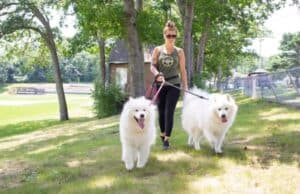
Have a new puppy or dog already?
Just Around the Corner offers a wide variety of dog walking and pet care options for you and your furry family member. We all know how difficult it can be to leave our dog home alone while we are at work; JAC is here to help. Set up a Meet and Greet with one of our pet care professionals. Choose from a variety of visits, walks, and hiking options that will best suit your dog and… VOILA! Instant peace of mind while you work, go out to dinner, or day trip to the Cape. Life is meant to be lived. Do not miss out on the fun while giving your pet the gift of JAC! It is a WIN-WIN! Call or text: 508-245-1389 to set up a Meet and Greet TODAY.
Just Around the Corner offers daily Dog Walking and Pet Sitting in Plymouth, MA. To learn more about how Just Around the Corner can help, check out our Services Page. You can also Contact Us for more information. Be sure to Like us on Facebook and Follow us on Instagram!

by Pam Ranheim | Jul 22, 2020 | cats, dog walking, dogs, pet care, pet health, pet sitting, pets
Your backyard is one of the safest places for your pup to spend their time, but it can also become deadly in the blink of an eye. Summer days with high humidity make the conditions ideal for dangerous plants and mushrooms to grow. If you are a dog owner, you know “everything goes in the mouth” especially new things they find in their personal space. Well, one mushroom or toxic plant in the mouth, when you are not looking, could become a deadly situation in a matter of hours. However, there are simple steps you can take to prevent your pet and you from dealing with the terrible effects of poisonous plants and mushrooms.
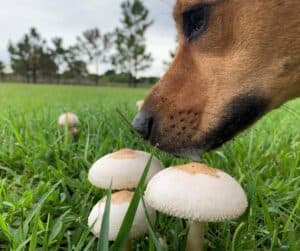
How to prevent poisonous plant ingestion
Clear ALL mushrooms in your yard.
When in doubt, take it out! Better to be safe than sorry so if you see mushrooms you are not sure about in your yard go ahead and dig them up. Be sure to pull them up by the “root “ (or mycelium) if possible, to help prevent further growth. This will not guarantee that they will not come back so keep an eye out. If you wish to keep non-harming mushrooms in your yard educate yourself on the types of mushrooms and their qualities. Learn more here: Types of toxic mushrooms
Be on the lookout for mushrooms outside of your yard too!
If mushrooms can grow in your well-manicured yard they can certainly grow along trails, sidewalks, and those hidden places your pet loves to sniff out for a potty break. Keeping an eye out while on walks, hikes and in new places (even a friend’s yard) is key to keeping your pet safe and plant poison free!

Know which plants are toxic to pets
While mushroom awareness is particularly important due to their quick appearance, easy access to pets, and difficulty to identify, they are not the only plants you should be on the lookout for. The same precautionary actions mentioned above should be taken with any poisonous plant. Here are some of the most common plants to be aware of.
• Azalea
• Hydrangea
• Ivy
• Daffodil
• Poinsettia
• Foxglove
• Tulip
• Lily
• Hyacinth
To name a few… Many of these plants are commonly found in flower arrangements as well as flower gardens. If you purchase flowers or plants or are gifted an arrangement be sure to double check the contents before leaving it within reach of your fur babies. Check out a complete list of toxic and non-toxic plants here: https://www.aspca.org/pet-care/animal-poison-control/toxic-and-non-toxic-plants
Identifying a poisoned pet
While some symptoms of poisoning are very evident not all signs come on at once or right away. If you suspect your pet has ingested part or all of a poisonous plant be on the lookout for these telltale signs.
- Vomiting
- Diarrhea
- Blood
- Fever
- Excessive drooling
- Weak/Uncoordinated Movements
- Seizures
- Strong heartbeat
If your pet exhibits any of these signs, contact your vet or poison control (800-222-1222) right away. Time is critical when getting care for poison.
Have a plan!
As a pet parent we hope to never deal with something so terrible as poison ingestion but nonetheless we must be prepared.
- Put important phone numbers in your contacts AND in a prominent place like your refrigerator for easy access. Regular vet, emergency vet and Poison Control are a few numbers to have on hand.
- Identify the plant involved and take a sample with you to your emergency location.
- Keep your pet’s medical records in a convenient location. The more information you can provide your pet’s medical professional the better they will be able to care for them.
- There is no home remedy you can offer your pet for this circumstance so get in touch with a medical professional ASAP
With so many toxic plants out there prevention can feel overwhelming, but with a few precautionary actions poisonous plant ingestion in pets is 100% preventable.
• Know what is in your yard
• Remove all dangerous plants from spaces your pet occupies
• Regularly check your pets’ spaces for new growth/potential danger
• Be familiar with the signs of a poisoned pet
• Have a plan of action
If you are having trouble identifying a plant in your yard a veterinarian or pet care professional may be able to help you. Call your vet or visit www.aspca.org for more information.
Just Around the Corner offers daily Dog Walking and Pet Sitting in Plymouth, MA. To learn more about how Just Around the Corner can help, check out our Services Page. You can also Contact Us for more information. Be sure to Like us on Facebook and Follow us on Instagram!




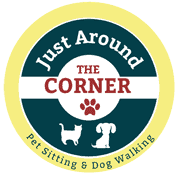




















Recent Comments